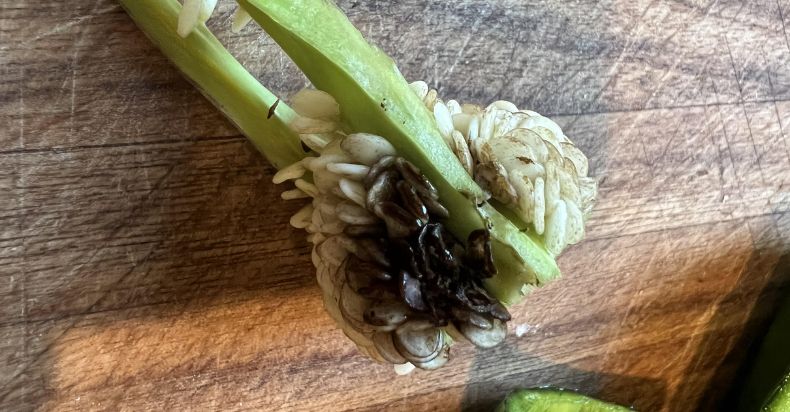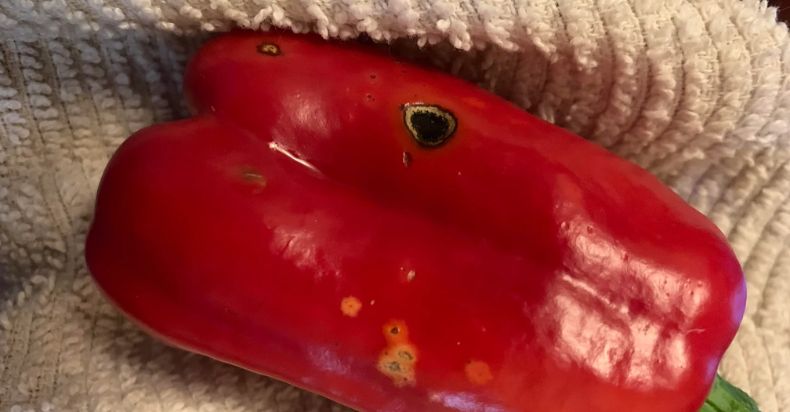Ah, bell peppers! Those vibrant, crunchy veggies that add a pop of color and a punch of flavor to any dish. They’re like the confetti of the vegetable world, aren’t they? Red, yellow, green, orange – they’re not just pretty to look at, but they’re also packed with vitamins and antioxidants.
But here’s something that might have you scratching your head. Ever cut open a bell pepper and found black spots inside? Kind of like someone took a tiny black marker and dotted the inside of your pepper? Yeah, that. It’s a bit of a downer, isn’t it? You’re all set to whip up a delicious stir-fry or a healthy salad, and then…black spots.
These black spots can be quite perplexing. They don’t look particularly appetizing, and they can make you question whether the pepper is safe to eat. After all, we’re often told to avoid fruits and vegetables with blemishes or discolorations. But are black spots in bell peppers the same as mold in bread or bruises in apples? Or is it something else entirely?
The mystery of the black spots in bell peppers is what we’re going to unravel in this article. We’ll delve into what causes these spots, whether they pose any health risks, and how to handle bell peppers with black spots. So, buckle up and get ready for a deep dive into the world of bell peppers!
READ : Is It Safe To Eat Broccoli With Brown Spots?
What Causes Black Spots in Bell Peppers?

Ok… sooo, what’s with the black spots anyway? Well, they could be caused by a number of things. Sometimes, it’s just a result of the pepper aging. As bell peppers mature and start to go past their prime, they may develop these black or dark areas. It’s kind of like wrinkles for peppers, huh?
Another cause could be a condition known as “black mold” or “black spot”, which is a type of fungal disease. This usually happens when the pepper is exposed to overly humid conditions or has been damaged in some way, allowing the fungus to enter and spread.
Then there’s something called “blossom end rot”, which can also cause black spots in bell peppers. This condition is usually a result of calcium deficiency and can be seen as a dark, sunken spot on the blossom end of the pepper.
Are Black Spots a Sign of Disease or Decay?
Now, you might be thinking, “Disease? Decay? Yikes! Should I be worried?” Well, not necessarily. While black spots can be a sign of these issues, they don’t always mean your bell pepper is bad or unsafe to eat.
In many cases, the black spots are just areas of the pepper that have started to oxidize or age. It’s similar to how an apple turns brown after you cut it open and leave it out for a while. It might not look as appealing, but it’s generally safe to eat.
However, if the black spots are due to a fungal disease, it’s a different story. Consuming moldy food can lead to foodborne illnesses, so it’s best to avoid eating bell peppers with black mold.
In the case of blossom end rot, the affected area is usually removed and the rest of the pepper can be consumed safely. But again, if the rot has spread significantly or the pepper has a rotten smell or texture, it’s better to err on the side of caution and discard it.
So, as you can see, the black spots in bell peppers can mean different things. It’s all about understanding what’s causing them and making an informed decision about whether to eat the pepper or not. But don’t worry, we’ll delve deeper into this in the next section. Stay tuned!
READ : Is It Safe to Eat Mushrooms With Brown Spots?
Can You Eat Bell Pepper With Black Spots?

Alright, let’s cut to the chase. Can you eat bell peppers with black spots? Well, the answer is… it depends. I know, I know, you were probably hoping for a simple ‘yes’ or ‘no’. But hey, when it comes to food safety, it’s better to be safe than sorry, right?
If the black spots are just a result of the pepper aging or oxidizing, then yes, you can still eat it. The taste might be slightly different, and the texture might be a bit softer, but it's generally safe to consume. Just make sure to wash the pepper thoroughly before using it.
However, if the black spots are due to fungal disease or blossom end rot, it's a different story. As mentioned earlier, consuming moldy food can lead to foodborne illnesses. So, if you suspect that your bell pepper has black mold, it's best to discard it.
Similarly, if the pepper has blossom end rot, you should cut off the affected area before eating the rest of the pepper. If the rot has spread significantly or the pepper has a rotten smell or texture, it’s better to toss it.
Health Risks Associated with Eating Spoiled Bell Peppers
Now, you might be wondering, “What’s the worst that could happen if I eat a bad bell pepper?” Well, consuming spoiled or moldy food can lead to a range of health issues, from mild digestive discomfort to serious foodborne illnesses.[source]
Symptoms can include nausea, vomiting, diarrhea, abdominal pain, and in severe cases, fever and chills.
So, while it might seem like a waste to throw away a bell pepper with black spots, it’s not worth risking your health. When in doubt, throw it out!
In the next section, we’ll talk about how to properly handle and store bell peppers to prevent black spots. So, keep reading!
How to Properly Handle and Store Bell Peppers
Selecting the Best Bell Peppers
First things first, let’s talk about how to pick the best bell peppers. When you’re at the grocery store or farmers market, look for peppers that are firm, shiny, and heavy for their size.
The skin should be taut and wrinkle-free, and the stem should be green and fresh-looking. Avoid peppers with blemishes, soft spots, or black spots.
Remember, the best defense against black spots is to start with a healthy, high-quality bell pepper. So, take your time and choose wisely!
Proper Storage to Prevent Black Spots
Now, once you’ve got your perfect peppers, how do you keep them that way? Proper storage is key. Bell peppers like cool, but not too cold, temperatures. The vegetable drawer in your refrigerator is usually a good spot.
Store your bell peppers in a plastic bag, but leave it slightly open or poke a few holes in it to allow for air circulation. This can help prevent moisture buildup, which can lead to mold growth.
If you’ve cut into a bell pepper but didn’t use all of it, no worries! Just store the leftover pepper in a sealed container in the fridge. It’s best to use it within a couple of days to enjoy it at its freshest.
By selecting good quality bell peppers and storing them properly, you can enjoy these colorful veggies without worrying about black spots.
In the next section, we’ll wrap up everything we’ve learned and answer some frequently asked questions. So, stick around!
Verdict: To Eat or Not to Eat?
So, there you have it! The mystery of the black spots in bell peppers, solved. As we’ve learned, these spots can be caused by a number of things, from simple aging to fungal diseases.
Whether or not it’s safe to eat a bell pepper with black spots really depends on what’s causing the spots.
If it's just a case of the pepper getting a bit old, then it's generally safe to eat. But if there's a chance the spots are due to mold or rot, it's best to play it safe and discard the pepper. Remember, it's not worth risking your health over a piece of fruit!
And of course, the best way to avoid this dilemma is to prevent black spots in the first place. By choosing high-quality bell peppers and storing them properly, you can enjoy these nutritious and delicious veggies without worry.
Frequently Asked Questions
Can bell pepper with black spots make you sick?
If the black spots are due to mold or rot, then yes, eating the bell pepper could potentially make you sick.
Symptoms of foodborne illness can include nausea, vomiting, diarrhea, and abdominal pain.
If you’re unsure whether your bell pepper is safe to eat, it’s best to err on the side of caution and discard it.
How can I tell if a bell pepper is bad?
A bad bell pepper may have soft spots, wrinkles, or areas of dark discoloration. It may also have a rotten smell or a slimy texture.
If your bell pepper has any of these signs, it’s best to throw it away.
How long do bell peppers last in the fridge?
Whole bell peppers can last for 1-2 weeks in the fridge, while cut bell peppers should be used within 2-3 days for the best quality.
Can you eat the seeds of a bell pepper?
Yes, bell pepper seeds are safe to eat, but they have a bitter taste that some people may not like.
It’s usually best to remove the seeds before using the pepper in your cooking.
Are bell peppers healthy?
Absolutely! Bell peppers are low in calories and rich in vitamins and minerals, particularly Vitamin C and various carotenoids.
These nutrients have antioxidant properties, which can help protect your body against damage from harmful free radicals.
So, bell peppers are not just tasty, but also good for your health.
